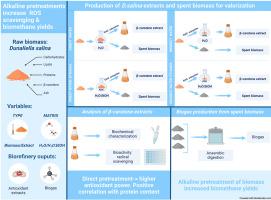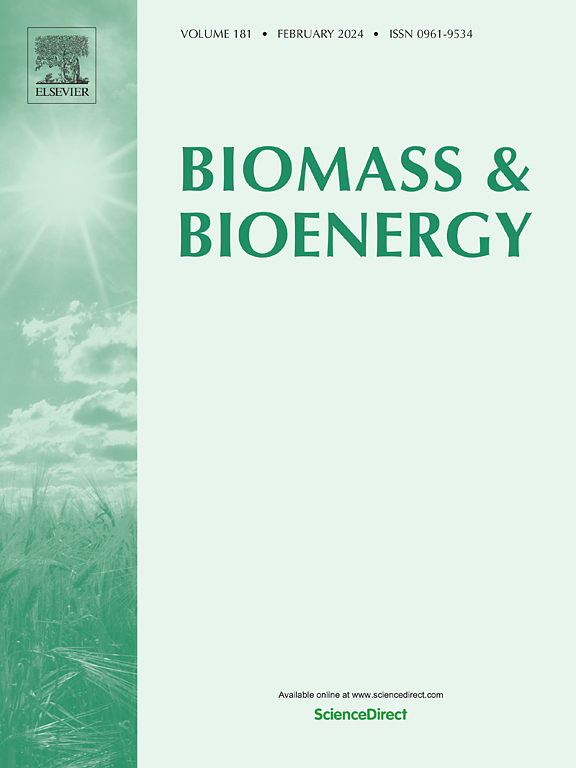Can mild alkaline pretreatment simultaneously enhance the antioxidant capacity of Beta-carotene extracts and biomethane yields in a sustainable Dunaliella salina biorefinery?
IF 5.8
2区 生物学
Q1 AGRICULTURAL ENGINEERING
引用次数: 0
Abstract
This research aims to assess the effect of alkaline pretreatments on the antioxidant potential of β-carotene-rich extracts from the microalga Dunaliella salina and the cumulative biomethane production from its spent biomass, within the framework of a circular economy approach using four biorefineries. A solvent screening was performed, with ethyl acetate achieving the maximum β-carotene extraction yield (5.3% ± 0.03%). Alkaline pretreatments were applied to the initial biomass (direct) and extracts after a extraction with ethyl acetate (indirect), using two matrices: water (W) and a mixture water:ethanol (WE). Direct alkaline pretreatments (D) offered extracts with higher potential than indirect pretreatments (I) in terms of: i) antioxidant capacity, as measured by ABTS•+ assay (0.69±0.1 and 0.61±0.1 mmolTE/gDW for W-D and WE-D, respectively, and 0.55±0.1 and 0.53±0.1 mmolTE/gDW for W-I and WE-I, respectively) and •OH scavenging activity (1.89±0.2 and 2.05±0.5 mmolTE/gDW for W-D and WE-D, respectively, and 0.48±0 and 1.2±0.3 mmolTE/gDW for W-I and WE-I, respectively), ii) biomethane production from their spent biomass (301±14 mLCH4/gVS and 289±9.0 mLCH4/gVS for W-D and WE-D, respectively, compared to 235±57 mLCH4/gVS without alkaline pretreatment), and iii) sustainability analysis, which includes the assessment of the biomass exploitation for β-carotene extraction and biomethane production. The most sustainable biorefinery was W-D as it achieved the highest biomass exploitation (33.8%), compared to WE-D (29.1%), W-I (33.1%) or WE-I (32.8%). This underscores the novelty and effectiveness of direct alkaline pretreatments for enhancing both antioxidant potential and energy recovery from D. salina biomass in a biorefinery context.

在可持续的杜纳藻生物炼制过程中,弱碱性预处理能否同时提高β-胡萝卜素提取物的抗氧化能力和生物甲烷产量?
本研究旨在利用四个生物炼制厂,在循环经济方法框架内评估碱性预处理对从微藻杜纳利藻(Dunaliella salina)中提取的富含β-胡萝卜素的提取物的抗氧化潜力以及从其废弃生物质中产生的累积生物甲烷产量的影响。对溶剂进行了筛选,其中乙酸乙酯的β-胡萝卜素提取率最高(5.3% ± 0.03%)。对初始生物质(直接)和乙酸乙酯萃取后的提取物(间接)进行了碱性预处理,使用了两种基质:水(W)和水与乙醇的混合物(WE)。在以下方面,直接碱性预处理(D)提供的提取物比间接预处理(I)具有更高的潜力: i) 抗氧化能力,用 ABTS-+ 分析法测量(0.69±0.1 和 0.61±0.1 mmolTE/gDW,W-I 和 WE-I 分别为 0.55±0.1 和 0.53±0.1 mmolTE/gDW)和 -OH 清除活性(W-D 和 WE-D 分别为 1.89±0.2 和 2.05±0.5 mmolTE/gDW,W-I 和 WE-I 分别为 0.W-I和WE-I分别为0.48±0和1.2±0.3 mmolTE/gDW);ii) 用过的生物质生产生物甲烷(W-D和WE-D分别为301±14 mLCH4/gVS和289±9.0 mLCH4/gVS,而未经碱性预处理的生物质为235±57 mLCH4/gVS);iii) 可持续性分析,包括评估提取β-胡萝卜素和生产生物甲烷的生物质利用情况。与 WE-D(29.1%)、W-I(33.1%)或 WE-I(32.8%)相比,W-D 的生物质利用率最高(33.8%),因此是最具可持续性的生物精炼厂。这凸显了直接碱性预处理的新颖性和有效性,可在生物精炼中提高盐湖虾生物质的抗氧化潜力和能量回收。
本文章由计算机程序翻译,如有差异,请以英文原文为准。
求助全文
约1分钟内获得全文
求助全文
来源期刊

Biomass & Bioenergy
工程技术-能源与燃料
CiteScore
11.50
自引率
3.30%
发文量
258
审稿时长
60 days
期刊介绍:
Biomass & Bioenergy is an international journal publishing original research papers and short communications, review articles and case studies on biological resources, chemical and biological processes, and biomass products for new renewable sources of energy and materials.
The scope of the journal extends to the environmental, management and economic aspects of biomass and bioenergy.
Key areas covered by the journal:
• Biomass: sources, energy crop production processes, genetic improvements, composition. Please note that research on these biomass subjects must be linked directly to bioenergy generation.
• Biological Residues: residues/rests from agricultural production, forestry and plantations (palm, sugar etc), processing industries, and municipal sources (MSW). Papers on the use of biomass residues through innovative processes/technological novelty and/or consideration of feedstock/system sustainability (or unsustainability) are welcomed. However waste treatment processes and pollution control or mitigation which are only tangentially related to bioenergy are not in the scope of the journal, as they are more suited to publications in the environmental arena. Papers that describe conventional waste streams (ie well described in existing literature) that do not empirically address ''new'' added value from the process are not suitable for submission to the journal.
• Bioenergy Processes: fermentations, thermochemical conversions, liquid and gaseous fuels, and petrochemical substitutes
• Bioenergy Utilization: direct combustion, gasification, electricity production, chemical processes, and by-product remediation
• Biomass and the Environment: carbon cycle, the net energy efficiency of bioenergy systems, assessment of sustainability, and biodiversity issues.
 求助内容:
求助内容: 应助结果提醒方式:
应助结果提醒方式:


